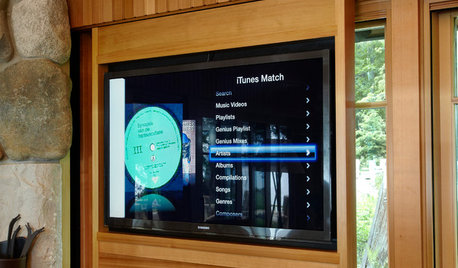X-ray Wiring Service?
bobb_2010
14 years ago
Related Stories

DIY PROJECTSHide All Those Wires in a DIY Charging Station
Keep your gadgets handy and charged with a flexible storage board you can design yourself
Full Story
FURNITUREModern Icons: Eames Shell Chair
Eames' Comfy Shell Chair Adds Welcome Curves, Wire or Wood to a Room
Full Story
BUDGETING YOUR PROJECTConstruction Contracts: What to Know About Estimates vs. Bids
Understanding how contractors bill for services can help you keep costs down and your project on track
Full Story
HOME TECHSave Your Decor — Hide Your Media Stuff
When you tuck boxes, wires and speakers into walls and ceilings, all you'll notice is your favorite shows or music
Full Story
HOME TECHNew Strategies for Hiding the TV
Its easy to be discreet when you've got cabinets, panels and high-tech TV hiders like these
Full Story
THE ART OF ARCHITECTUREDesign Workshop: Put Industrial Mesh to Work Around the Home
From open gratings to fine weaves, commercial metal mesh is a durable and beautiful choice for residences too
Full Story
MODERN ARCHITECTUREBuilding on a Budget? Think ‘Unfitted’
Prefab buildings and commercial fittings help cut the cost of housing and give you a space that’s more flexible
Full Story
THE ART OF ARCHITECTURELaser-Cut Focus: The Future of Design Is Here
Discover how this laser technology can make almost any pattern a reality
Full Story
EXTERIORSGreat Design Element Our Grandparents Knew All About: Awnings
This time-tested feature for shading and cooling is enjoying a resurgence
Full Story
GARDENING AND LANDSCAPINGSeek Shelter in the Shade This Summer
Open up to outdoor living with 8 garden shade strategies
Full Story









brickeyee
joed
Related Professionals
Murraysville General Contractors · Alamo General Contractors · Ames General Contractors · Chillicothe General Contractors · Dunkirk General Contractors · Gloucester City General Contractors · Leavenworth General Contractors · Markham General Contractors · Orangevale General Contractors · Sterling General Contractors · Broomfield Home Automation & Home Media · Leesburg Home Automation & Home Media · Naperville Home Automation & Home Media · Robbinsdale Home Automation & Home Media · East Setauket Home Automation & Home MediaBilll
Ron Natalie
bobb_2010Original Author
pharkus
bobb_2010Original Author
petey_racer
brickeyee
Billl
bobb_2010Original Author
hrajotte
weedmeister
Billl